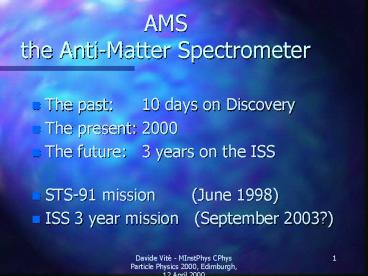AMS the AntiMatter Spectrometer - PowerPoint PPT Presentation
1 / 13
Title:
AMS the AntiMatter Spectrometer
Description:
Davide Vit - MInstPhys CPhys Particle Physics 2000, Edimburgh, 12 April 2000. 1. AMS ... 168 10x10cm2 7cm thick solid cells ... from 0.1 to 200 GeV. Gamma ray search ... – PowerPoint PPT presentation
Number of Views:25
Avg rating:3.0/5.0
Title: AMS the AntiMatter Spectrometer
1
AMSthe Anti-Matter Spectrometer
- The past 10 days on Discovery
- The present 2000
- The future 3 years on the ISS
- STS-91 mission (June 1998)
- ISS 3 year mission (September 2003?)
2
AMS in space
- the first large magnetic spectrometer
- i.e.
- the first particle physics experiment
- and
- the biggest silicon system
- in operation to date
3
AMSPhysics Goals (1)
- Measurement of H, He, C isotopes
- better understanding of cosmic ray origin and
propagation in the galaxy - Antiprotons and positrons
- search for exotic sources
- High energy photons (gt 1 GeV)
- complementary to satellite and ground telescopes
4
AMSPhysics Goals (2)
Search for antimatter primary goal of AMS, up to
Z 6
- Antimatter discoveryantistars, primordial
antimatterExplanation for antimatter domain
formation?
- No antimatter foundexplanation for antimatter
disappearance?Strong CP-violation?
Antihelium could originate from primordial
nucleosynthesis OR from antistars anticarbon
could ONLY come from antistars
5
Apparatus for the precursor flight AMS-01 (1)
- Construction and test of detector elements
- assembly, integration, system tests
- space qualification outgassing, vibrations
- Permanent magnet
- 1.2m diameter, 80cm height, 1.9 tons
- 0.15 Tesla
- blocks of Nd-Fe-B of high field strength
6
Apparatus for the precursor flight AMS-01 (2)
- Tracker
- 4 inner planes and 2 outer planespartially
equipped (40) - 57 modules of 11 to 15 double-sided DC silicon
microstrip detectors - front-end Viking/High Dynamic Range4ms peaking
time, 0.7 mW/ch - 365W allocated (out of 1 kW), 0.5 Mbit/s (out of
1), 5MHz ADC on ext. TDR
7
Apparatus for the precursor flight AMS-01 (3)
- Time-of-flight - 4 planes
- trigger
- particle velocity and absolute charge
- Anticoincidence - 16 counters
- background rejection (albedo)
- Aerogel Threshold Cherenkov - 2 planes
- 168 10x10cm2 7cm thick solid cells
8
The STS-91 Discovery missionJune 2-12, 1998
- Final tests at KSC and installation on the
Shuttle Discovery - Launch data download to JSC
- slow rate, high rate
- Landing at KSC back to Europe
- Beam tests ( cosmic muons)
- GSI-Darmstadt Helium, Carbon
- Cern-Geneva charge-1 particles
9
Physics from STS-91
- Search for antihelium
- 2,86 million helium nuclei observed
- rigidity 1 to 140 GV
- Search for antimatter
- Cosmic ray proton spectra
- from 0.1 to 200 GeV
- Gamma ray search
10
AMS on the International Space Station AMS-02
- design finalisation and optimisation
- space qualification of single elements
- assembly, full space qualification, long term
operation - lt2 tons, 2kW, 10g, ?T, (micro)meteorites
- installation on the Space Station (2003)
- 3 to 5 years of data taking
- (if we get He refill)
11
Apparatus for ISSAMS-02 (1)
- Superconducting magnet
- Oxford Instruments, 1T (vs. 0.14T)
- Tracker 8 layers, fully equipped
- 192 modules of 7 to 15 double-sided DC silicon
microstrip detectors, 10?m/30?m resolution - some 200,000 readout channels
- Synchrotron Radiation Detector (SRD)
- x-rays from high energy electrons in B(E)
- 2400 Crystal/PMT elements, 4800 channels
12
Apparatus for ISSAMS-02 (2)
- RICH Aerogel radiator, ??/? ? 10-4
- cosmic ray id. up to 13 GeV per nucleon for A lt
25, charge id up to Z ? 26 - ECAL 3d sampling calorimeter
- 80 layers of lead and fibers, 15.5 X0
- 0.5 GeV to 1 TeV, proton rej. ? 10-4
- TRD (Transition Radiation Detector)
- 20 layers of radiators and prop. tubes
13
so (conclusions)
- Lots of
- work
- we still have to build it !
- physics
- data in 2003 !
- (and fun)!
- HEP physicists (almost) in space (more or less..)
!































